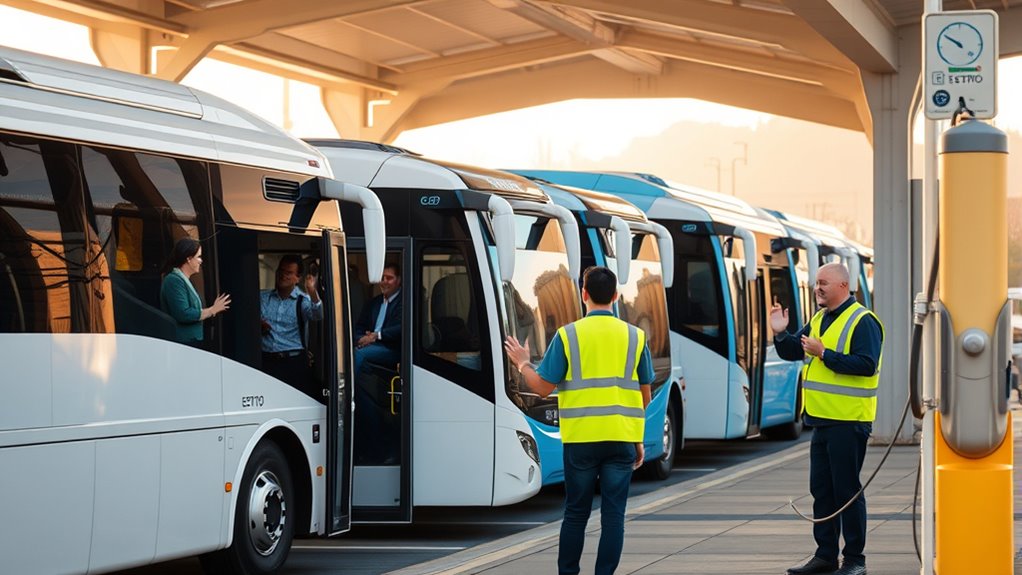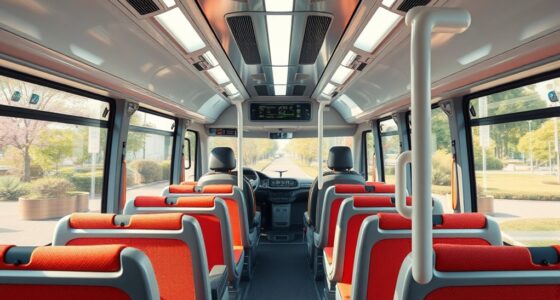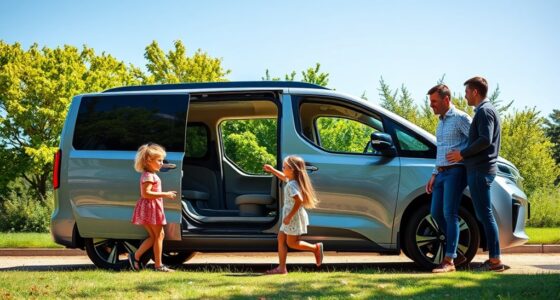Customers love the switch to electric buses because of the smoother, quieter rides and improved comfort. They notice less noise and vibrations, creating a calming travel experience. Passengers also appreciate cleaner air and a modern, inviting interior. Cities report high satisfaction scores, highlighting that electric buses make commutes experience better overall. If you want to discover more about why these changes are making a difference, keep exploring.
Key Takeaways
- Passengers praise the smoother, quieter ride, enhancing overall travel comfort and experience.
- Improved interior design with wider windows and modern seating creates a more inviting environment.
- Reduced air pollution and cleaner air onboard contribute to passenger health and satisfaction.
- The quiet, stable ride and advanced features foster confidence and trust in electric bus performance.
- High satisfaction scores reflect positive feedback on environmental benefits, comfort, and overall transit quality.

Customer testimonials reveal how electric buses are transforming urban transit by delivering a smoother, quieter, and more comfortable ride. When you step onboard these vehicles, you notice the difference immediately. The enhanced suspension and electric drivetrain create a ride that’s markedly more comfortable, with fewer vibrations compared to traditional diesel buses. Passengers often describe the experience as “very smooth,” especially in the latest models equipped with advanced suspension systems. The modern dash displays provide real-time energy monitoring, giving both operators and riders confidence in the vehicle’s efficiency and performance. You’ll see that acceleration and braking are consistent, making trips feel seamless and predictable.
Electric buses offer smoother, quieter rides with advanced suspension and real-time energy monitoring for enhanced comfort and confidence.
The passenger-centric design plays a crucial role in increasing satisfaction. Wider windows flood the interior with natural light, improving visibility and creating a more inviting atmosphere. Inside, the layout is optimized for comfort, with modern seating arrangements and spacious configurations that accommodate more passengers comfortably. The cabin remains considerably quiet, a feature that passengers frequently praise for its calming effect, especially during longer trips. Safety features are enhanced during boarding and travel, giving everyone peace of mind. All these elements combine to make electric buses not just a practical choice but a preferred one for daily commuters.
Beyond comfort, electric buses greatly reduce their environmental impact. When you ride them, you’re directly contributing to cleaner air in urban areas, thanks to the elimination of tailpipe emissions. Regenerative braking captures energy, boosting efficiency and extending the range of each charge. Many cities now charge these buses with renewable energy sources like wind or hydro power, making the entire transportation process even greener. Retrofitting older diesel buses with electric drivetrains extends their lifespan and maximizes investments, reducing the need for new vehicle procurement and supporting sustainable growth. Additionally, the use of air purifiers in buses can further improve passenger comfort by filtering out pollutants and allergens, ensuring a healthier environment onboard. Modern energy management systems help optimize vehicle performance and energy use, further enhancing operational efficiency. Incorporating smart charging infrastructure also helps balance energy demand and optimize charging schedules, improving overall system reliability.
Operational efficiency is another compelling reason to switch. Maintenance costs plummet because electric buses have fewer moving parts, and predictive analytics help optimize routes and energy use, reducing downtime. They integrate seamlessly with existing charging infrastructure, often featuring modular components that simplify repairs and upgrades. Fleets can scale up easily, supporting large metro systems’ expansion plans and aligning with global zero-emission goals for 2030. These efficiencies translate into cost savings, which are often passed on to riders through improved service and infrastructure investments.
Customer satisfaction metrics strengthen the case. In places like Gothenburg’s Route 55, electric buses have earned record-high satisfaction scores. Surveys reveal passengers prefer electric over diesel models, citing cleaner air, quieter rides, and a more pleasant interior environment. Increased willingness to choose electric routes and positive feedback on ambiance highlight the growing acceptance and enthusiasm among riders. Coupled with government incentives and operational savings, these testimonials make it clear why many transit authorities have made the switch.
Electric buses not only meet current demands but also position urban transit systems for a sustainable, efficient, and rider-friendly future.
Frequently Asked Questions
What Is the Initial Cost Difference Between Electric and Diesel Buses?
You’re wondering about the initial cost difference between electric and diesel buses. Electric buses usually cost between $250,000 and over $400,000, while diesel buses are generally between $50,000 and $100,000.
The higher price of electric buses mainly comes from battery costs.
However, subsidies and funding options can help offset this gap, making electric buses more affordable over the long run despite the higher upfront investment.
How Long Do Electric Bus Batteries Typically Last?
Imagine your bus’s battery as the heartbeat of the journey. Typically, it lasts 5 to 7 years, but with advanced technologies and careful maintenance, it can stretch up to 12 or even 15 years.
High-quality batteries, like CATL’s Tectrans, offer longer lifespans.
Proper care and environmental awareness can make your e-bus’s energy source resilient, powering your routes with reliability and sustainability for years to come.
Are There Any Government Incentives for Switching to Electric Buses?
You’ll find that there are many government incentives to help you switch to electric buses. Federal programs like the EPA’s Clean School Bus Program offer billions in rebates and infrastructure support.
Additionally, tax credits such as the Qualified Commercial Clean Vehicle Credit reduce purchase costs. State and local incentives further lower expenses with rebates, reduced electricity rates, and infrastructure assistance, making the change more affordable and environmentally friendly.
How Do Electric Buses Perform in Extreme Weather Conditions?
You might wonder how electric buses handle extreme weather. They perform well in cold conditions thanks to their balanced weight distribution, which improves traction and stability on snowy roads.
While the range drops by about 30-40% in very cold temperatures, proper planning and pre-heating help guarantee they can still complete routes.
What Is the Maintenance Cost Comparison Between Electric and Traditional Buses?
When comparing maintenance costs, electric buses remarkably outshine traditional diesel models. You’ll spend less on repairs because electric motors have fewer moving parts, and there’s no need for oil changes or exhaust system repairs.
Regenerative braking reduces brake wear, and simpler drive systems cut maintenance time.
Industry data shows electric buses can save you up to $125,000-$135,000 over their lifespan, making them a more cost-effective choice.
Conclusion
Switching to electric buses isn’t just a trend; it’s a smart move backed by real experiences. Customers like you find that electric buses reduce costs, cut emissions, and boost community pride. While some worry about range or charging times, the evidence shows technology is advancing quickly. Embracing electric buses proves you’re making a responsible choice for the environment and your passengers. It’s clear: going electric isn’t just a theory — it’s a proven solution for a better future.









